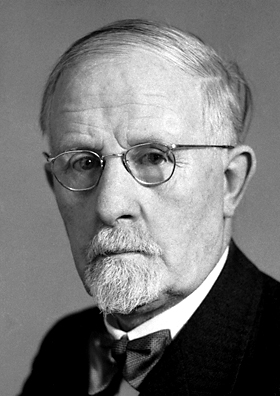Walter Rudolf Hess
Walter Rudolf Hess (17 March 1881 – 12 August 1973) was a Swiss physiologist who was awarded the Nobel Prize in Physiology or Medicine in 1949 for his discovery of the functional organization of the interbrain as a coordinator of the activities of the internal organs. This work was instrumental in demonstrating how the brain controls internal organs through the autonomic nervous system, significantly advancing the understanding of brain function and its effect on the body.
Early Life and Education[edit | edit source]
Walter Rudolf Hess was born in Frauenfeld, Switzerland. He pursued his education in medicine at the University of Zurich, where he was deeply influenced by the work of his mentors in the fields of physiology, ophthalmology, and neurology. After obtaining his medical degree, Hess dedicated himself to research in physiology, focusing on the nervous system and particularly on how the brain influences the heart and blood vessels.
Career and Research[edit | edit source]
Hess's career was primarily based at the University of Zurich, where he conducted most of his groundbreaking research. His early work involved studies on the cardiovascular system, but he is most renowned for his experiments on the brain. Using a technique known as electrical stimulation, Hess was able to map regions of the brain that are responsible for controlling various internal organs. His research demonstrated that the hypothalamus, a small region at the base of the brain, plays a crucial role in coordinating the autonomic nervous system, affecting heart rate, digestion, respiration, and other involuntary functions.
One of Hess's significant contributions was the concept of functional organization within the brain, suggesting that different areas of the brain are specialized for different functions. This work laid the foundation for later research in neurophysiology and neuroscience, fields that continue to explore the complexities of brain function and its impact on health and behavior.
Nobel Prize[edit | edit source]
In 1949, Walter Rudolf Hess was co-awarded the Nobel Prize in Physiology or Medicine with Egas Moniz, a Portuguese neurologist who developed leucotomy (a form of lobotomy) for treating mental disorders. Hess's portion of the prize was given for his elucidation of the role of the interbrain in controlling the internal organs, a discovery that has had lasting implications for medicine and psychology.
Legacy[edit | edit source]
Walter Rudolf Hess's work has had a profound impact on the field of neuroscience, providing insights into how the brain regulates bodily functions and the physiological basis of consciousness and behavior. His research has paved the way for further studies on the autonomic nervous system and its relationship to stress, emotion, and physical health. Hess's legacy is remembered for his meticulous research methodology and his contributions to our understanding of the brain's role in regulating the body.
Selected Publications[edit | edit source]
Throughout his career, Hess published numerous articles and books detailing his research findings. Some of his most influential works include studies on the interconnections between the brain and heart function, as well as the regulatory mechanisms of the circulatory system.
Death and Honors[edit | edit source]
Walter Rudolf Hess passed away on 12 August 1973. His contributions to physiology and medicine have been recognized through various awards and honors, including the Nobel Prize. His legacy continues to influence current research in neuroscience, physiology, and the medical sciences.
Transform your life with W8MD's budget GLP1 injections from $125
W8MD offers a medical weight loss program NYC and a clinic to lose weight in Philadelphia. Our W8MD's physician supervised medical weight loss centers in NYC provides expert medical guidance, and offers telemedicine options for convenience.
Why choose W8MD?
- Comprehensive care with FDA-approved weight loss medications including:
- loss injections in NYC both generic and brand names:
- weight loss medications including Phentermine, Qsymia, Diethylpropion etc.
- Accept most insurances for visits or discounted self pay cost.
- Generic weight loss injections starting from just $125.00 for the starting dose
- In person weight loss NYC and telemedicine medical weight loss options in New York city available
- Budget GLP1 weight loss injections in NYC starting from $125.00 biweekly with insurance!
Book Your Appointment
Start your NYC weight loss journey today at our NYC medical weight loss, and Philadelphia medical weight loss Call (718)946-5500 for NY and 215 676 2334 for PA
Search WikiMD
Ad.Tired of being Overweight? Try W8MD's NYC physician weight loss.
Semaglutide (Ozempic / Wegovy and Tirzepatide (Mounjaro / Zepbound) available. Call 718 946 5500.
Advertise on WikiMD
|
WikiMD's Wellness Encyclopedia |
| Let Food Be Thy Medicine Medicine Thy Food - Hippocrates |
Translate this page: - East Asian
中文,
日本,
한국어,
South Asian
हिन्दी,
தமிழ்,
తెలుగు,
Urdu,
ಕನ್ನಡ,
Southeast Asian
Indonesian,
Vietnamese,
Thai,
မြန်မာဘာသာ,
বাংলা
European
español,
Deutsch,
français,
Greek,
português do Brasil,
polski,
română,
русский,
Nederlands,
norsk,
svenska,
suomi,
Italian
Middle Eastern & African
عربى,
Turkish,
Persian,
Hebrew,
Afrikaans,
isiZulu,
Kiswahili,
Other
Bulgarian,
Hungarian,
Czech,
Swedish,
മലയാളം,
मराठी,
ਪੰਜਾਬੀ,
ગુજરાતી,
Portuguese,
Ukrainian
Medical Disclaimer: WikiMD is not a substitute for professional medical advice. The information on WikiMD is provided as an information resource only, may be incorrect, outdated or misleading, and is not to be used or relied on for any diagnostic or treatment purposes. Please consult your health care provider before making any healthcare decisions or for guidance about a specific medical condition. WikiMD expressly disclaims responsibility, and shall have no liability, for any damages, loss, injury, or liability whatsoever suffered as a result of your reliance on the information contained in this site. By visiting this site you agree to the foregoing terms and conditions, which may from time to time be changed or supplemented by WikiMD. If you do not agree to the foregoing terms and conditions, you should not enter or use this site. See full disclaimer.
Credits:Most images are courtesy of Wikimedia commons, and templates, categories Wikipedia, licensed under CC BY SA or similar.
Contributors: Prab R. Tumpati, MD



